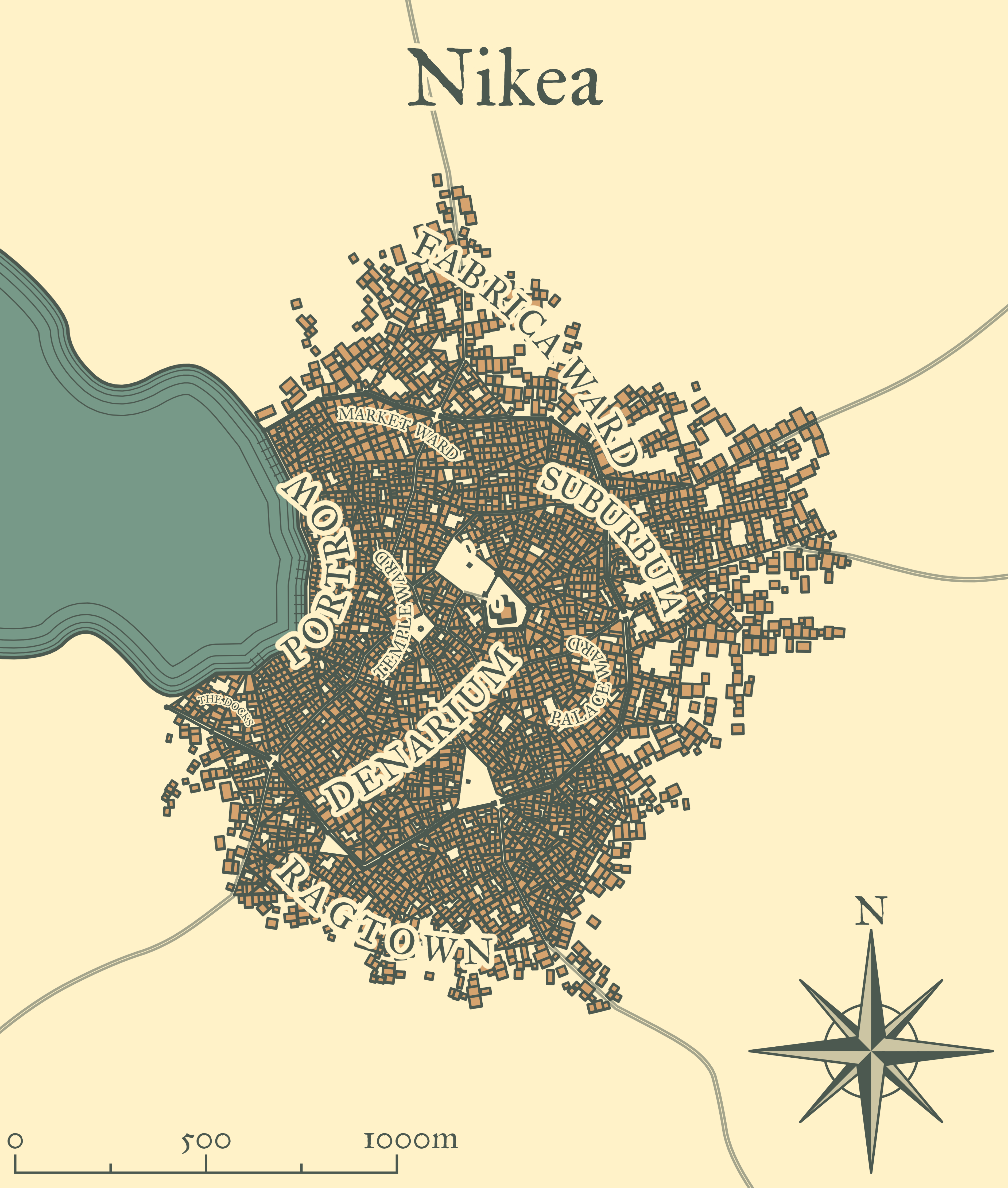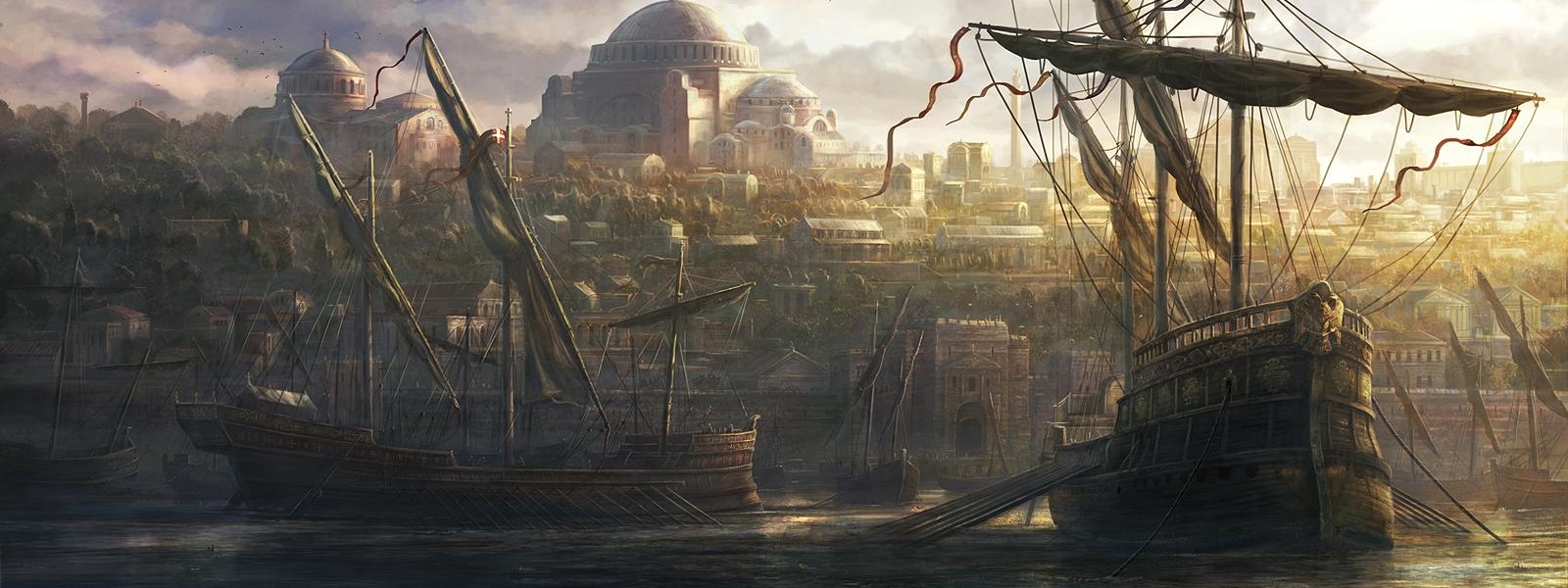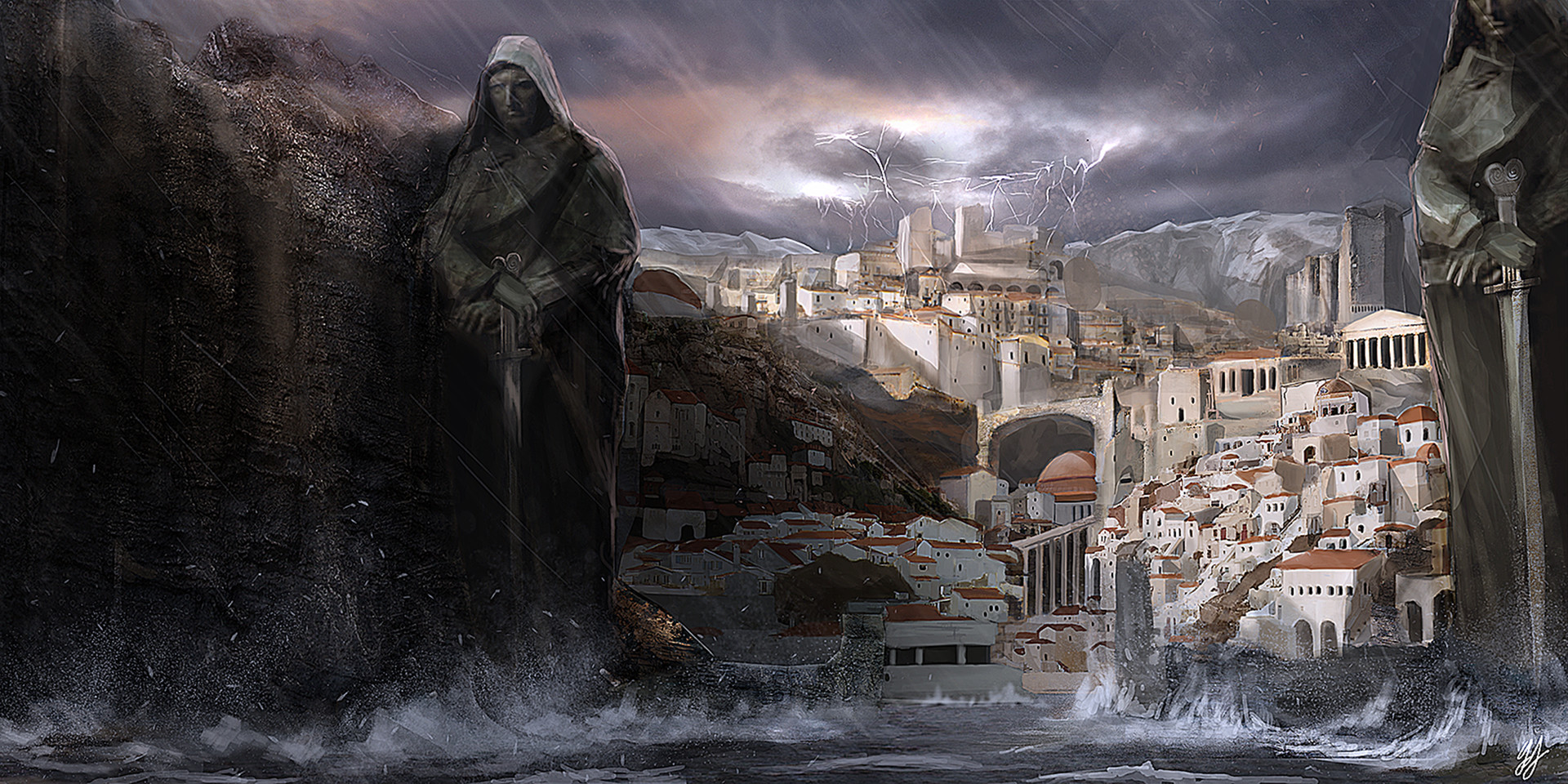Nikea (/ nikeiɘ /)
Ναϊκια
As you pass into the port of Nikea, you feel the Great Colossi on your flanks, almost as if they are staring at you. The city itself rises steeply into the hills a solid mountain of terracotta wales, roofing tiles, and great stone archways. The echoes of the marketplace rin in your ears and the belching smoke coming from the great foundries near the port make breathing difficult. The city seems to pulse with energy, and many eyes seem upon you.The city of Nikea was established on an estuary of the River Ilos, and a break in the escarpment along the coast. It is one of the oldest, largest, and most influential cities in the Aeillan region. It is the largest city, and the capital of the Republic of Nikea, and is one of the premier cities in Aeilla. As one of the largest ports on the Aeillan coast, it is host to trade from Leandris and Felora, as well as the coastal trade lanes.
Wards of Nikea
There are 8 large wards and a smaller district that make up the city of Nikea. Most of the most prestigious of these are located within the city's walls or on the nearby hills, with the fabricae and slums to the east and west being new, more poorly maintained, and less prestigious. The wards of Nikea are as follows:The Palace Ward: Against the eastern walls of the city, the Palace district of Nikea is, some of the old aristocratic nobility, and the wealthiest of the merchant class. The seat of government is located here, in the Palace of Nikea, as is the city's citadel, as well as a number of other government buildings made up for the civil service. As one radiates away from the palace there is a higher number of wealthy residences.
Temple Ward: The Temple Ward in the heart of the city radiates out from the Hippodrome and the Temple of Maretal the Storm God, people who provide services to the main temple, as well as the smaller temples scattered throughout the ward live here as well. Also of note is the Schola Magos, the finest institution of learning for would-be mages in Aeilla, which exists in this district.
Portrow: Hugging the Ilos Estuary is Portrow. Built, unsurprisingly, around the docks, the Portrow is host to a number of warehouses, drydocks, and maritime industries as well as a quarter for foreign traders. There are few residences in this district, mostly flophouses for sailors.
The Docks: A smaller district attached directly to Portrow, "The Docks" are a military district, housing the dedicated shipwrights and docks for the Nikean Navy, as well as the garrisons for naval sailors, barracks for Nikean Penandroi, and the headquarters for the City Watch. Security is tight in this district, and outsiders are held under suspicion.
Market Ward: Near the Portrow and hugging both sides the north wall is the commercial district. This maze of bazaars, market stalls, and winding roads has steadily expanded in the last couple of centuries and has now sprawled outside the walls. In these markets, one can find most goods or services available on the mortal plane. Suburbia: The wealthiest of the neighborhoods outside the city, Suburbia is the ward bearing the homes of most of the city's mercantile classes, many of its civil servants, and some of the less wealthy nobles, as well as the part-time homes of nobles from outside the city.
Ragtown: The outermost slums of Ragtown live on the edge of the city, built up around the ruins of an ancient and abandoned settlement, this deeply impoverished district is a den of squalor and crime, and often serves as prime recruitment grounds for public works labor, the military, and mercenary bands as people here have few other economic prospects.
The Fabrica Ward: The newest of the city's district the Fabrica ward is centered around a handful of major manufacturing centers, and barracks for the workers therein. It is precariously placed though, as many buildings are nestled in the steep hills of the northern slope. This district has grown rapidly in recent years as the industrial output of the city has ramped up dramatically.
Important Locations
The Colossi of Nikea: Perhaps the most defining features of the city are the two great stone Colossi which flank the breaks in the Nikean escarpment, and mark the entrances to the city's harbor. These massive constructions are ancient, maybe predating the city itself, and are shrouded in mystery. Some say the Colossi are inhabited by powerful protective spirits that ward the city from serious danger, though many are skeptical of this claim.The Schola Magos: The Schola Magos is the oldest scholarly institution for mages in Aeilla, as well as being the largest, and one of the finest. It is here that many young Aeillan wizards train their abilities and first start their careers as court wizards, magical artisans, and adventurers.
The Temple to Maretal: The largest temple in the city, dedicated to Maretal, the Pandroi Storm God, one can find many sailors here, praying for the safe voyage as well as other supplicants who see kindred with the volatile deity.
The Hippodrome: The largest entertainment venue in the city, the hippodrome, also dedicated in part to Maretal, serves as the center of the city's culture, thousands flock to the arena during the major horse racing events, and it is here the political double-dealing, trade negotiations, and even plain sports hooliganism can be found in abundance. Indeed the central nature of the hippodrome means that it has itself become an important political tool.
The Nikean State Armaments Foundry: Located at the wall-side edge of the Fabrica District, the Nikean State Armaments Foundry is one of the largest centers for weapon manufacturing in Galisea, it is here that the firelocks, cannons, and much of the armor for the Nikean Pandandroi are made. Officially, weapons made are for military use only, but many an enterprising smuggler has extracted a few smaller weapons for sale.
Ragtown Ruins: Located at the heart of Ragtown, the Ragtown Ruins are a collection of ancient ruins that have largely remained uncovered and actively avoided by the slum-dwellers. In these ruins are the main entrances archaic and mysterious tunnels that run under much of the city, and though many have been picked clean, some of the old ruined buildings are rumored to still have secret hollows with artifacts thought lost to time.
The Aquilarius Estates: The Estates of the ancient and mysterious Aquilarius patrician house. This family in antiquity once held the power of the city but were displaced by the Imperial Exarchate system, and some think that they seek revenge for this wrong. It is certainly true, however, that they pay good coin for mysterious deeds done without question.
Demographics
The city of Nikea is home to 115,715 residents, with most, 82,121 being noncitizen freemen, and the remaining 33,594 being full citizens of the Republic. As Nikea is a free state, there are no slaves in the city, and foreign slaves are liberated upon entrance as a matter of course. The population is overwhelmingly human, with 90,210 residents being humans, with Ilosi Aeillans being the dominant ethnicity. Most nonhumans are half-breeds with Nikea having a uniquely (second only to Antiokus) large proportion of half-elven citizens. The bulk of Nikea's aristocracy has at least seasonal residence in Nikea, and as a result, there is a large population of aristocrats, 14,210 to be exact, living in the city.
Government
As the seat of the Republic of Nikea, the city of Nikea is governed directly by the senate, and specifically the Proconsul, a title which is currently held by the great and energetic reformer Theodora Victoria Laskaris. Power in the city is held tightly by the Proconsul, largely as a means of wresting control away from the powerful old guard of the aristocracy. The new republican system perhaps more than the old Exarchate relies on a robust civil service with large numbers of educated scribes, skilled workers, and law enforement in the form of the reave, the watch, and other such persons to maintain control, infrastructure, and the general good function of the city.
Defences
The city is principally defended by wall dating back to the establishment of the Aeillan Empire, even as the city itself has outgrown this defense. There are two internal citadels around the Palace, and near the Temple of Maretal Guarding it is an 1,800 strong force of watchmen, a permanent peacetime garrison of Penandroi and Hetairoi, as well as a sizable contingent of the Nikean Navy. It is also rumored the Colossi of Nikea serve as protectors for the city, powering a magical ward to shield it from harm.
Industry & Trade
The city of Nikea maintains substantial manufacturing capabilities including a large ironworks, a significant textile industry, a and modest shipwright, as well as the largest armaments industry in Aeilla. Goods produced in Nikea flow outward into the commercial wards, the ports, and over the ocean. As the industrialization of Nikea has continued so to has the rapid growth of its merchant class and a large, though primitive financial sector has sprung up in recent times. Nikea is bustling with trade, largely exporting manufactured goods, and the skill of its engineers made in the city to import food and exotic spices produced far away.
Infrastructure
Nikea is one of the old, highly developed cities of the Old Empire, and as a result can expect only the finest luxuries available in civilized Aeilla. A series of aqueducts carries water into the city, and its numerous bathhouses, and a developed sewer network carries sewage out, keeping the streets clean. The city's harbor is serviced by several large docks which are capable of handling extensive shipping traffic. Nikea is at the point of convergence for five major roads, and is a regional road hub. In at least the sections of the city behind the walls, there are streetlights crafted by the priesthood and powered by perpetual magical light. Critical sections of the city are protected by magic wards, and some automated transport occurs, largely carrying stone blocks into the city to maintain stone edifices.
Guilds and Factions
Since the establishment of the Nikean Republic, power has become concentrated in the hands of the newly formed senate, and the Proconsul, this political new political power has decentralized control somewhat to various competing intrests. Mercantile power, has long been suppressed, though as the economy has shifted, they have steadily gained in strength, and the Sailor's Guild, Merchant's Guild, and the banks have gained the potential to enforce their will on the young republic. Another major force in the form of the skilled tradesfolk has arisen with smiths, shipwrights, masons and other such skilled workers forming powerful guilds of their own. Lastly, there is the old aristocracy, which while disempowered, holds considerable sway, particularly outside the wall.
History
Founded in EF 7, near the ruins of a long lost civilization, the city of Nikea was a natural place to found a city. Quickly growing up around the estuary of the Ilos, and the natural harbor therein. As the region became more densely settled the population of Nikea ballooned, as did the resultant political influence. Nikea became a major regional power, establishing one of the most powerful Poleis in central Aeilla.
The Polis of Nikea was a signatory to the Ilosi League, and a founding member of the Ilosi Republic, granting it inordinate power as the Ilosi Republic, and later the Aeillan Republic expanded outward to encompass much of the Aeillan Region. When the Republic transitioned to Empire, the resulted centralization of power, weakened Nikea's influence, and even though it remained one of the finest cities of the Empire it went into steady decline throughout the Imperial Period, until the Feloran invasions, and the resultant breakup of the Empire shortly thereafter allowed Nikea to reassert dominance on the Aeillan stage.
As the period of the Successor States has worn on, Nikea has only grown in influence as a series of dynamic rulers, each trying to cement the legitimacy of their own house has secured a steadily stronger position for the city and the wider Republic. Most recently, Nikea has been an early, and aggressive adopter of primitive industrialization, which has resulted in an economic boom for the city, a tend which has accelerated rapidly under the newer republican government which took power after the death of the last exarch.
Geography
Nikea is situated around the mouth of a sheltered estuary which forms a natural harbor for it. The terrain is fairly steep however, as much of the city is close to deep escarpments and large hills. As a result growth patterns favored following the least steep rises possible, with western sprawl being limited until only fairly recently. Therefore, much of the city lies to the west of its old centers, with comparatively little development to its east.

Map of Nikea by Javak
Founding Date
EF 7
Type
Large city
Population
115,715
Inhabitant Demonym
Nikean, Nikeans
Location under
Owner/Ruler
Ruling/Owning Rank
Owning Organization



